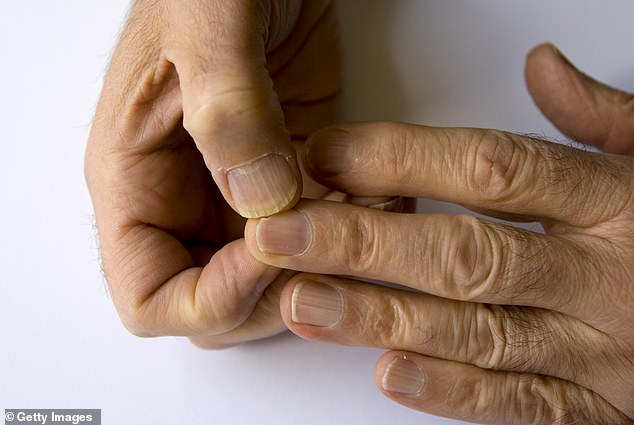An Australian nutritionist has revealed how changes in your fingernails can signal underlying health problems.
Fiona Tuck, from Sydney, said the nails are usually reflective of what the body is experiencing internally, but may take weeks or even months to show up.
‘Nail health can tell us whether an individual is lacking certain nutrients, such as iron or zinc, whether something more severe is occurring or if external factors have damaged the nail itself,’ Fiona told Daily Mail Australia.
‘It’s important to consider all the possibilities and look at all the fingernails, not just one and not the toenails.’
White spots or lines
Many people will often experience white spots on the nails, which is usually an indication of a zinc or calcium deficiency.
‘These will look like white, little spots or lines on the nail – if you’re noticing these on all of the nails, it can be a sign of not getting enough zinc or calcium,’ Fiona said.
This factor is quite simple to reverse by consuming more foods containing these two vitamins.
For calcium, Fiona suggests eating more dairy products and leafy green vegetables, while eating more pumpkin seeds, oysters, poultry and red meat can boost zinc levels.
Pale or blue nails
It’s important to notice any changes in the nails, particularly the colour of the nail beds.
Fiona said healthy nails are always a natural pink colour, but pale or slightly blue nails could suggest a low blood circulation around the body.
Nails of this colour can also suggest a lack of iron in the body, which can be determined by getting a blood test or considering dieting factors.
Once the nutrients deficiency has been corrected, Fiona said the deformity in the nail will change and grow out.
If the individual has poor blood circulation, this can be boosted by exercising more frequently.
Pitted nails
Pitted nails is a less common condition, but often occurs when the body is experiencing more sinister illnesses.
‘Pitting looks like tiny dots or pricks on the nail and this usually occurs when there’s a kind of autoimmune condition taking place within the body,’ Fiona said.
‘This is common among those who have psoriasis, a type of skin disease, or alopecia, which is when hair loss occurs.’
Fiona said these factors can be genetic, but are worth getting checked by a doctor or specialist.
Ridges on the nails
If the nails are growing to form a ridge or vertical lines, this can be indicative of further deficiencies or issues associated with the gut.
Fiona said the nails have a tendency to grow slower or form these ridges when the gut is not absorbing or receiving enough nutrients.
‘Ridges in the nails could be a sign of numerous nutrient deficiencies, such as protein, iron, zinc or minerals,’ she said.
She added this is why it’s essential to consider individual diets and what is consumed on a daily basis to help determine what might be going wrong internally.
Clubbed nails
Clubbed nails are most common among older people and these nails are formed with the nail bed curving downwards.
This formation can be indicative of severe internal issues correlating to lung conditions or disease.
‘When the nails are clubbed or if they curve downwards, this can relate to breathing difficulties, lung conditions or even cardiovascular issues,’ Fiona said.
‘The nails often look enlarged at the ends of the fingers.’
External factors
Before seeing a doctor, it’s also important to consider whether any external factors may have impacted the growth of the nail.
Fiona said these factors can include fake nails, bumping the nail, peeling or ripping the nail or any other elements that may physically harm the nail.
She said nails can also become dry by excessively washing the hands, not moisturising or using too much hand sanitiser.
DailyMail


